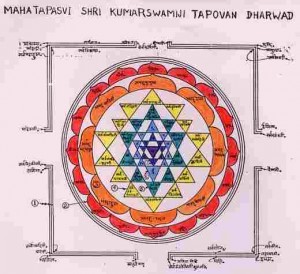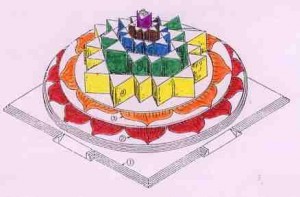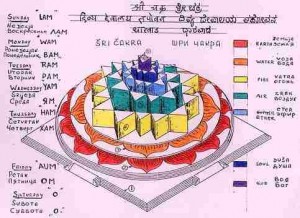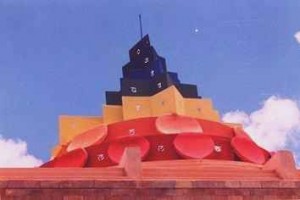The precise nature of Shiva-Shakti has been a matter of considerable metaphysical discussion. Shakti is distinguishable from Shiva only in conventional analysis but in realization she is identical with Shiva. If Shiva is Sat being in itself, Shakti is Sati being in itself as power. If Shiva is chit pure consciousness, Shakti is chiti consciousness as power. If Shiva is ananda, bliss, Shakti is ananda-lahari, wave of bliss. Shiva polarizes himself into the subject and object into aham and idam by virtue of Shakti inherent in him. By the process of polarization that which is unmeasured becomes measured, the infinite is made finite and the undifferentiated becomes differentiated. Thus reality evolves into a universe of being and becoming. In this world of becoming the essential thing to achieve is the recognition of lost unity which must be worked out consistently and thoroughly, without leaving any precipitated difference whatever. The outward going process is one of differentiation and diversification, but the incoming process must be one of increasing assimilation and identification. In the first every-thing is projected into separateness and exclusiveness; in the latter, it is drawn back and gathered into unity and peace. The kundalini yoga is a practical demonstration of how the evolving process is reverse, until the consciousness of the whole universe is resolved into unitary consciousness and perfect bliss.
There are two ways of reaffirming the lost identity. One is elimination or negation till negation is no longer possible. This is the neti method of the Vedanta. It is to negate as unreal the crust or sheath of a given object. If the upadhi of any given object be similarly eliminated, it will be seen that in the kernel the one is the same as the other and each is atman or Brahman. The other way is of sublimation or transformation. The method of sublimation consists of sadhana or purification, uddhara or elevation and Chaitanya or reaffirmation of identity in consciousness. By the first the thing or an act is purged of its dross and it is done by reversing the direction of the world process. The next stage is elevation which consists in making the ascent reach the level of perfect experience which is parahanta. The last step consists in the affirmation and realization of consciousness of the supreme identity.
The Tantra classifies human nature under three heads in accordance with three gunas of Sattva, Rajas and Tamas. A man with divya or divine disposition is known as Sattvic; a man with vira or heroic disposition is known as rajasic; a man with a pashu or animal disposition is known as tamasic. Tamasic man does not deserve the title of sadhak for the simple reason that he moves with the outgoing current and earns merit or demerit while moving with it. He has not subdued the vasanas or instinctive urges and cut the three knots of hate, fear and shame. The sadhaka competent for the left path or vama-marga is the Vira or hero who has assailed kundalini at the base of the spine and made her turn and rise. There is a final divya or mahabhava state in which bonds do not exist but the semblance of them is dissolved in the ocean of nectar.
Closely connected with the three bhavas are the seven acharas or rules of conduct which are as follows: Veda, Vaishanva , Shaiva, Dakshnia, Vama, Siddhanta and Kaula. In the first stage, cleanliness of the body and mind is cultivated. The second stage is that of devotion; the third is of Jnana. Dakshnia is that stage in which the gains acquired in the preceding stages are consolidated. This is followed by Vama which is the stag of renunciation. The sixth stage is characterized by a conviction to adhere to the path of renunciation. In the last stage Kaula or Brahman becomes a reality to the aspirant. The first three of the seven stages belong to the pashu-bhava; Dakshina and Vama belong to divya bhava. He truly is liberated in this life who knows the seven acharas comprised within three bhavas. Wrongly understood and in a distorted sense, the pancha makara has played havoc. By the five makaras are meant – wine, meat, fish, cereals, and sexual union. These five articles have esoteric meaning. It is to be noted that what one is required to offer is the tattva or principle and not the article itself. The object of using these five tattvas in worship is to secure return current which seeks to reverse the process of creating and maintaining the complexes in which the jiva or soul has been held captive. This return current which is known as nivritti in Vedanta goes by the name of Vamamarga or the left hand path in the Tantras. The reverse of Dhara is Radha, of hamsah is soham, this is Vama. The whole theory and practice of the Vamachara is based on this principle. Every finite centre is in fact a reversible apparatus. In ordinary life the apparatus works with a sign and with a certain result, which is a bondage in complexes. Some of these complexes appear to be cardinal which are the prime movers of the soul in his ordinary activities. These constitute the key knots of the net of wandering in which jiva is caught and held. The left hand path or Vamamarga is simply a means of using these cardinal impulses of bhoga or enjoyment in such a way that their sign may be changed and their very nature be sublimated or transformed.
The Kularnava Tantra offers esoteric meaning of the five makaras barring the cereals as follows: “the wine which gladdens is the nectar which flows from the union of the Kundalini Shakti with Shiva at the Sahasrara in the head, and he drinks this nectar while others are mere wine bribers. That man who kills by sword of jnana the animals of merit and demerit leads his mind to the supreme Shiva is said to be a true eater of flesh. That man truly takes fish who controls all his senses and places them in his Atman, and others are mere killers of animals. The Shakti of the pashu is not awakened but that of the Kaulika is. The man who enjoys this Shakti is said to be a true enjoyer of Shakti. He is permeated by the bliss which arises out of the union of the supreme Shakti and Atman which is the true union, others are no better than fornicators.”
It may be seen that in the pancha makara is hidden the mystic truth garbed in symbolism. Symbolism is used to serve as a means to clothe plain truth in imagery. By drunkenness the Persian mystic poets mean entire loss of self-consciousness – characteristic of unitive life at its highest level, the state of passing away of phenomenal self into the rapture of Love. In the pancha makara madya or wine is the foremost, and it plays an important role both in Tantrism and Sufism. The ordinary meaning of madya is wine, but its esoteric meaning is God-intoxication. The sympathizers of Sufism say that the Sufi, when he calls for a wine does not mean the red juice of the grape but the wine of God’s grace. In fact the Sufi is not drunkard, for wine is prohibited to him. So when he calls for wine, he does not want that kind of drink which drives away wisdom, but he wants that pure and unmixed juice whose hidden power vanquishes fate; that wisdom which saves us from the burden of all mistakes; that clear wine which sanctifies the heart; that illuminating wine which points out the true path; that pearly wine which purifies the mind and its fancies. By wine Omar Khayyam meant God-intoxication, for he knew well that God is love and everyone that loveth knoweth God.
So far so good; but what is the actual condition? The ordinary run of mankind takes things at their face value, and runs the risk of falling into a pit of degeneration and debauchery. Why even the aspirants are, at times, at their wits end to grasp the hidden meaning of the cryptic sayings and to assimilate them into their daily life. Hence symbolism of the plain truth should not be countenanced.
It has been said that the Tantras are the system of mantras and an elaborate process of auto-suggestion. Of very great importance are the letters of Alphabet because they are called matrika, the mother. They are collectively the source from which every word and every mantra is evolved. Mantra shastra is another department of the occult science which has for its object acquirement of power for securing the object aimed at, by means of invoking the gods presiding them, by repeating such mantras or formulas as are intended for the purpose with the necessary ceremonies attending thereto. For the successful study and practice of this mantra shastra the purity of body, speech and mind is the first condition; otherwise it would lead to black magic and its disastrous results.
The process of auto-suggestion is to turn the round the self, so that it may be in harmony with the process of divine imagination from which the universe arises and in which it subsists. If things come to exist and live by God’s suggestion, they will come to exist and live by the suggestion of a Siddha who lives, moves and has his being in divine consciousness. The Mantric develops the powers by appealing to external objects such as gods and goddesses, while the yogi develops them by self culture or by identifying himself with the divine ground. The yogi by self-purification, meditation, and the power of will puts himself in tune with the grantor of all the boons, since the whole involved at every point, contact and communication can be established with the whole at any point of the universe.
The Tantric literature mentions the Chakras which are seven in number. These are independent units carrying on their assigned functions. Each chakra has a Shakti controlling its own activity. In addition to these independent Shaktis of each Chakra there is a universal Shakti which has the power of controlling all the Chakras. This universal Shakti which is known as Kundalini in the Tantras, is lying dormant and coiled up like a serpent in the base of the spine of an individual. The lower most Chakra with which Kundalini forms a connection is the basic plexus called the Muladhara Chakra. It has four branches known as petals. The Swadhishthan Chakra which has six petals is situated in pelvic region; it is the hypo-gastric plexus. Manipura Chakra, which has ten petals is situated in the region of the navel; it is the solar plexus which is some times known as Kundali Chakra. Anahata Chakra, which has twelve petals, is located in the region of the heart; it is known as cardiac plexus. Vishuddhi Chakra, which has sixteen petals, is located in the region of the throat; it is known as pharyngeal plexus. Ajna Chakra, which has two petals, is situated between eyebrows. Sahasrara which has thousand petals is situated at the top of the head; it is cerebrum.
The first and second charkas, having but few petals are concerned with receiving into the body the physical force that comes from the earth and the vital force that radiates from the sun. The charkas of the middle group, namely 3, 4 and 5 are concerned with the forces which reach man through his personality. Chakras 6 & 7 being connected with pituitary and the pineal glands are stirred into activity only when a certain amount of spiritual development has taken place.
‘The Divine Temple’ in Tapovan, Dharwad built by His Holiness Shri Swamiji is based upon ‘Shri Chakra’ principles of Shakti
In the whole range of Tantric literature, the concept of Shri Chakra as crystallized in Shiva-Shakti stands foremost and represents culmination of the Tantric Sadhana. Shri Chakra is a symbol of the Universe both macrocosm and microcosm. There are in it two sets of triangles, one set composed of four Shiva triangles and the other of five Shakti triangles. In the centre reside Shiva and Shakti in an undifferentiated union. Enclosed in the centre is an inverted triangle representing the iccha (will), kriya (action) and jnana (knowledge) aspects of shakti, the three gunas and the deities presiding over them. All the nine triangles are rules over by the divinities presiding over forms of mind, sense and matter with their special functions. These divinities are but rays inherent in the central luminary and Shri Lalita is conceived of as being absorbed in Her. In the Upasana of Shri Chakra are harmonized the personal and impersonal aspects of God.
The Tantra philosophy emphasizes the indissoluble unity of Shiva and Shakti and seems to be more attracted to the cosmic play of Shakti. It does not commit itself to the extremes of Shakti completely withdrawn into Shiva or Shiva completely losing itself into Shakti. It emphasizes the integral unity of the two. Though there are states in which Shakti as an individual entity cannot be fully traced out and seems to be enjoying the quietude of Shiva, still such a state is not considered as the full truth, for it is only a phase in the play of Shakti. The integral association of Shiva and Shakti is therefore a greater and higher truth and hence if the Tantra philosophy is alive to the dignity of silence, it is equally alive to the dignity of life. The more we are installed in silence the better we live. The more we feel the in pouring the better we see the face of silence. This integral concept of Shiva-Shakti, makes it possible for the Tantra philosophy to unite all phases of existence and all kinds of knowledge.
– OM SHANTI | OM SHANTI | OM SHANTIHI –
This article ‘An Evaluation of the Tantras’ is taken from H.H.Mahatapasvi Shri Kumarswamiji’s book, ‘Dimensions of Yoga’.





